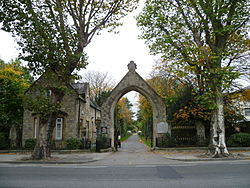This article has multiple issues. Please help improve it or discuss these issues on the talk page . (Learn how and when to remove these messages)
|
| Royal Borough of Kensington and Chelsea Cemetery, Hanwell | |
|---|---|
 Main entrance to the cemetery | |
 Interactive map of Royal Borough of Kensington and Chelsea Cemetery, Hanwell | |
| Details | |
| Established | 1855 |
| Location | 31 Uxbridge Road, Hanwell London W7 3PX |
| Country | England |
| Coordinates | 51°30′40.85″N0°19′54.29″W / 51.5113472°N 0.3317472°W |
| Type | Public |
| Owned by | Royal Borough of Kensington and Chelsea |
| Size | 7.7 hectares (19 acres) |
| Website | Official website |
| Find a Grave | Royal Borough of Kensington and Chelsea Cemetery, Hanwell |
Royal Borough of Kensington and Chelsea Cemetery, Hanwell (aka Hanwell Cemetery) is located on the north side of the Uxbridge Road in Hanwell, London, England. The cemetery was opened in 1855 to take the pressure off the burial grounds in St Mary Abbots parish in North Kensington. The Burial Act 1857 also mandated that new interments were to be carried out beyond the densely populated areas of London. The cemetery is designed in the Victorian style for parks, intricately landscaped with many curving paths. The cemetery is owned and operated today by the Royal Borough of Kensington and Chelsea.

